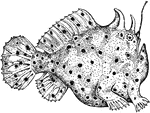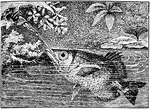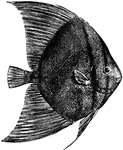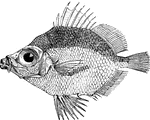74 illustrations of fish including: albacore, alewife, amberjack, anchovy, angelfish, angler, archerfish, bandfish, barbel, bass, bergylt, bib, bigeye, blackfish, bleak, blenny, blindfish, bluefish, bluegill, boarfish, bonito, bottlefish, bowfin, braize, bream, brill, bullhead, and burbot

Acanthoclinus
"(A fish that) had a compressed claviform body, posterior dorsal fins nearly opposite to the anus, prolonged…

Acanthodes Sulcatus
"Outline of Acanthodes sulcatus. p., Pectoral fins; v., pelvis; a., anal; d., dorsal." -Thomson, 1916
Acipenser Sturio
A type of Ganoid fish. Ganoid is an order of fishes included seven living genera, whose members are…

Albacore
"Albacore or Tunny(Tuna)- a name given to several fishes of the tunny or mackeral kind, specifically…

Alewife
"A North American fish, Clupea Vernalis, from 8 to 10 inches long, resembling a small shad, but much…
Amia Occidentalis
A type of Ganoid fish. Ganoid is an order of fishes included seven living genera, whose members are…
Amphisile scutata
"The body is much compressed, and is armed with bony plates connate with the vertebrae and spinous processes.The…
Anchovy
"A small silvery fish, four or five inches long; it is taken in vast numbers i nthe Mediterranean, where…
Anchovy
"A small fish, about a span long, much esteemed for its rich and peculiar flavor. It is not much longer…

Angelfish
"Notwithstanding its name is is a hideous-looking creature, with two enormous pectoral fins, said to…

Angelfish
"A plagiostomous fish. It is from 6 to 8 feet long, has a flat, roundish head, terminal mouth, and teerh…

Emperor of Japan Angelfish
The Emperor of Japan (Holocanthus imperator) is a species of fish in the Pomacanthidae family of angelfishes.

Angler
"The fishing frog is three to five feet long. It has an enormous mouth, armed with numerous pointed…

Angler
"The fish Lophius piscatorius, the typical representative of the family Lophiidæ."-Whitney, 1902
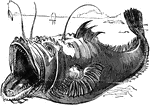
Angler
The angler (Lophius piscatorius) is a monkfish known for catching prey with a lure hanging above its…

Anglerfish
Anglerfish are the members of the order Lophiiformes. They are bony fish named for their characteristic…

Anomalops Palpebratus
"A genus of fishes, typical of the family Anomalopidæ: so called from the remarkable structure…

Archerfish
"To this fish has been ascribed the power of shooting drops of water to the distance of 3 or 4 feet,…

Archerfish
"Toxotes jaculator, a scaly-finned, acanthopterygian fish, about 6 in. long, inhabiting the seas around…

Red Bandfish
"One to two feet long, color orange-red; moving in the waters it appears like a red-ribbon. This, as…

Barbel
"Said to be called so because of the barbs or wattles about its mouth; it is common in the warm and…

Bass
"Labrax lupus (Bass), an Acanthopteryglan with anterior spinous and posterior soft dorsal fins." —…

Black Sea Bass
The Black Sea Bass (Centropristis striata) is a fish in the Grouper family native to New York, Maine,…

European Bass
"Is one to three feet long, and has been celebrated from the time of Aristotle for its richness and…

Sea Bass
"Sea bass has a white, flaky flesh, and weighs from 1 to 3 pounds. This fish responds to any cooking…

Small-Mouthed Black Bass
"1. Spiny portion of dorsal fin. 2. Soft portion of dorsal fin. 3. Caudal fin. 4. Anal fin. 5. Pectoral…

Striped Bass
"Striped bass is a soft-fleshed fish, sometimes called rockfish, averaging 2 to 5 pounds in weight.…

Bergylt
"Is twelve to twenty-four inches long; found in the northern seas, south to the coast of Massachusetts;…

European Blackfish
"Two to three feet long, remarkable for its swiftness and voracity; the color is black, the body covered…
River Blackfish
The River Blackfish (Gadopsis marmoratus) is an Australian fish in the Percichthyidae family of temperate…

Bleak
"The Bleak or Blick, L. alburnus, is a well-known, small species, inhabiting many of the rivers…

Ocellated Blenny
"Three to four inches long, the color pale-brown, lives among weeds, and feeds on crustacea; common…

Redlip Blenny
The Redlip Blenny (Ophioblennius atlanticus) is one of three species of blennies in the Perciformes…
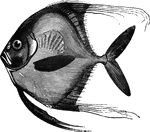
Blepharis
"Five to six inches long; blueish-white above, shiny beneath; found, though rarely, on the American…

Blowfish
Tetraodontidae is a family of primarily marine and estuarine fish. The family includes many familiar…
Bluefish
"Bluefish are sold whole, their average weight from 3 to 6 pounds. Snaper blues or oung fish, weigh…

Bonito
"Resembles the tuna in form, but is seldom more than thirty inches long. It is extensively distributed,…
Bowfin
The bowfin, a primitive freshwater fish, also known as the freshwater dogfish is a voracious fish.


